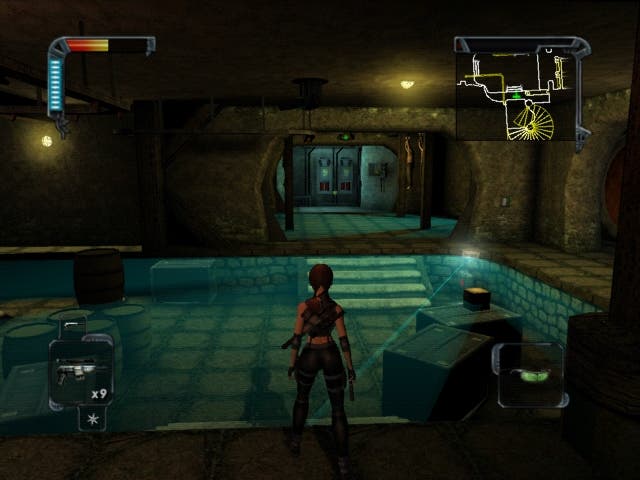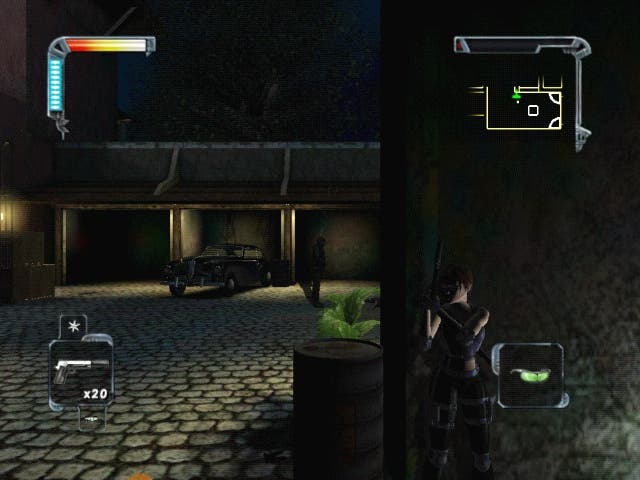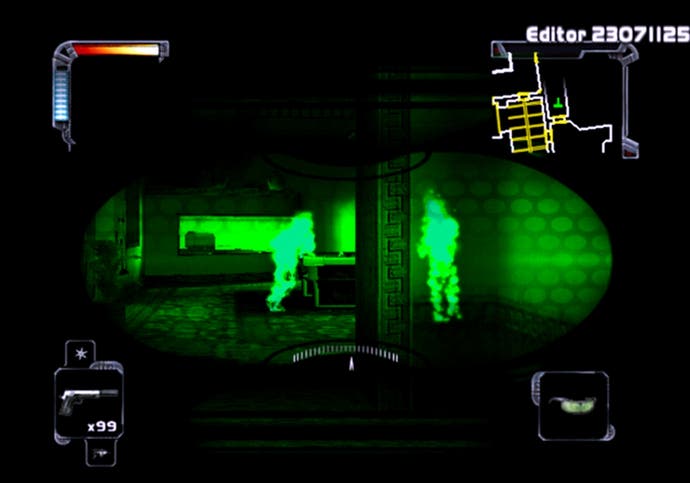Rogue Ops
We liked it before we played it...
Red-shirts. Those poor bit parts that always took point on away missions and wound up getting chided, chopped, chewed, chaliced and often choked by any indigenous creatures sensible enough to try and apprehend Captain Kirk. It's clear now that they were the lucky ones. Put a red-shirt in the average stealth-action game, and he'd realise what it truly is to be expendable. Having robbed from virtually every stealth orientated game released since the original Metal Gear Solid, Rogue Ops involves killing nameless guards by breaking their necks, shooting them in the head, sniping them from afar, slicing them up with shurikens, poisoning them with arrows, dumping fossilised dinosaurs on their heads, locking them in silos with detonating nuclear weapons, and of course leaping down and crushing their heads. Take that, Ensign Nobody.
Having suffered silently through Splinter Cell, lurking bored and irritable in the shadows, yearning to "apply my training" in the field whenever a guard's back was turned -- for all the world like a child straining to avoid pissing his pants -- Rogue Ops seemed like the ideal tonic. Scratch that, the ideal adrenalin shot to the heart. I needed to kill again. For me, stealth is no fun if you don't get to relieve the tension every once in a while. I'm also very hard to shock. Not in the "BOO!" sense, but in that I found Manhunt's execution system compelling and kind of enjoyed the finishing close-ups (I felt a bit like Bart and Lisa watching Itchy & Scratchy). I suppose the point is that I like to make sure I know what's behind me, which is harder to do when you've left a couple of AK-47 toting fundamentalists roaming around moaning about the weather, and if I get to see someone having their neck broken in the process, then that's all the better.
Murderously varied

With so many ways to kill a man, Rogue Ops ought to be great. It has a system whereby you can pause behind an enemy and hold off pressing the "kill" button until the last possible moment, in order that the number of buttons you have to press to perform the actual execution is reduced. On that basis, it ought to provide that rush of blood and build-up of tension that kept me playing Manhunt even after the novelty wore off. It also has labyrinthine levels, intricately designed to offer options and call upon all the gadgetry and technique at the player's disposal. So with that in mind it ought to allow the player to pick a clinical path of bodies and ticked objectives boxes, on the way to a clean and well rounded conclusion - as satisfying as the bits of The Mark of Kri that worked, and pretty much all of Tenchu: Wrath of Heaven. Furthermore, the context-sensitive "action" button ought to relieve so much of the fussy gadget management and complex control issues that made MGS2 and Splinter Cell frustrating for those without programmable thumbs.
However it's all blighted right from the get-go by... fussy gadget management and complex controls. It's an unhelpful control scheme that spoils an otherwise interesting if uninspired collection of good bits from other stealth-action games you've played. Otherwise the sales pitch is pretty simple - you get to navigate a secret lady through some big and fairly linear levels, topping and storing guards in the various aforementioned ways, collecting or killing whatever and whoever, and once you've cleared the whole thing out you get to watch a cut-scene, prompting some sort of final showdown or tricky set-piece. Checkpoint saves are spaced out reasonably consistently, and most situations can be approached a couple of ways. For example, you could run out and shoot a couple of guards, or you could tap a few keys on a nearby piano to attract the first one, snap and store his filthy neck and then cap the bloke who comes looking for him. Afterwards, you get some more CG video and some development of the predictable plot ahead of your next incursion.
It sounds promising. But promising or not, the result can be a pain and a slog. Your character, Nikki Connors, has to sleuth her way around keeping an eye out for guards, video cameras and booby traps using a third-person camera (right analogue stick), overhead radar map (expandable with the Black button) and toggle-able VISER infrared tool for spying trip-wires and heat signatures in other rooms. And of course from time to time she's spotted. If the guard calls it in, hits an alarm or whatever, the place goes nuts, alarms sound, and the bar atop your radar flashes red indicating that you're totally shagged. Other guards in the vicinity will come running, and they'll continue their search for a while. Fortunately, if you can hide quickly enough - perhaps standing Solid Snake-like in a locker or packing crate, or hiding amongst the roof rafters, or up in a vent, or lurking in the shadows with your Sam Fisher light detector on its lowest reading - then you stand a chance of waiting out their interest. Obviously like red-shirts these guys are built to act stupidly and die ingloriously, so once they've persisted for a preset amount of time they generally bugger off back to where they came from, often allowing you to sneak out and kill them as they walk away.
Paper cuts

On paper, it all sounds jolly good. Tense, silent infiltration is challenging and fun - particularly when it's tainted with brutality - so it's the nature of the game that you'll catch some flak now and then, and there are mechanisms to deal with it. Unfortunately though, they're not good enough. Ideally you just want to come up with a plan and watch it unfold as predicted, because reacting to anything on-screen is always a pain. Perhaps a guard spots you and comes running up a corridor. If you just want to gun him down, hit B (draw/holster), pull the left trigger (view/target mode), aim with the right stick (at his upper body or preferably head) and pull the trigger to fire. If you want to run, hold the camera stick far left or right until Nikki turns 180 degrees, then hold forward on the left stick. Then try desperately to get out of sight and find a locker so you can wiggle back and forward, strafing left and right and rocking the camera until the context-sensitive action button wakes up and offers to open the door for you. These aren't reactions, they're bizarre obfuscations; they're like booking the London Philharmonic Orchestra to play Twinkle, Twinkle Little Star for your one-year-old child. You shouldn't have bits where the gamer needs to hide quickly in a game that simply isn't designed well enough to react quickly and intuitively.
Mercifully, if you get shot too much then the game automatically applies any stored health packs, but that's about the only break you get. There are two other control types, and you can toggle the Y-axis inversion, but the lack of what I'd call proper analogue control is striking in every scenario. If it wasn't for the fact that you can sort of veer slightly when you run, I'd have to draw comparison to Resident Evil in terms of clunkiness, and as distributors Capcom would probably accept, that's a pretty harsh indictment for any third-person game. You could also argue that the lack of a run toggle - just a gradual increase in speed when using the analogue stick - distances this from Resi too, but to be honest a run button would be useful. Playing this on the Xbox pad, the gradual increase in speed occurs at certain thresholds of analogue tilt, and it often means you bash into a terrorist when you're trying to follow him closely, or nudge a laser beam when dodging through booby traps, simply because you went a fraction of the way into 'audible footsteps' territory. The control problems are even more acute midway through the game when you start using the first person "Fly Cam" to zoom around and plant bugs inside bizarrely well-guarded and spacious computer tunnel whatsits. The camera moves too slowly as well, with no acceleration or sensitivity options anywhere, and this engine doesn't lend itself to what is effectively a Descent clone mini-game...
Enemy of the state

There are basic design and consistency issues too that should surely have been spotted in testing. Example: Nikki's robbery of a private museum in dear old England. It's all about lurking in the shadows, which is all very well, except a) the guards clearly have torches, but can't see you sat three feet away from their faces, and b) the light meter is designed to show you that you're hidden from view by going dark, and that you're completely in the open by appearing transparent - very sodding useful when you happen to be crouching in what looks like a shadow in a pitch black British museum, and you can't work out whether you're looking at a solid black light meter or a black background peeking through the HUD.
It's also guilty of various sins we normally associate with this genre - a fact that doesn't make them any less reprehensible. Enemies who respawn in closed areas because you saw a cut sequence; occasional "cinematic" framing that just means you're seen before you can wrestle the game into looking at anything; enemies who can see you from above even though your sensors and camera angles barely keep track (and you can't move back and forward whilst using the infrared view, natch); and of course characters who sneak around at a snail's pace and still manage to snag themselves on anything approaching an angle. Did I mention the stick-twirling safe-cracking mini-games? Great fun if you like tackling the same pointlessly contrived obstacle fifty times, getting shot to pieces and having to wait for the alarms to shut off every time you screw it up...
Rogue opportunities

But overwhelming though my frustration must seem, Rogue Ops does occasionally show a bit of intelligence. Shoot a guard in the head and he's going to drip blood as you haul him away, but snap his neck and he can be hidden without a trace. Throw a shuriken at the ceiling above an entrenched enemy, and it will fall down and lash them in the face. What's more, each level is full of set pieces, and little pointless characters with things to say which may or may not have a bearing on your mission - find yourself halted by a body heat sensor, for instance, and you might want to locate and listen to guards wandering around nearby to sound out a solution. The action is also regularly interrupted for a little bit of comms banter with your counter-terrorist colleagues, who often influence your mission objectives or lay out the terms of engagement - even demanding that you kill six enemies with six specific bullets in one memorable finale.
It is also difficult to tire of it at the beginning due to the endless possibilities and increasing variety of mission objectives. Although you may fumble the controls more often than not, as long as you can get over the frustration of having to redo the odd room a few times every now and then, and look closely at the more detailed scenarios before you engage, progress is relatively consistent. It's also a nice "one level a day" sort of game, at least for a while. Even if I haven't enjoyed that luxury myself, I know the value of a game where each level feels like a new episode and takes upwards of an hour to complete.
War on terror - start here!

Ultimately though, when you review games you tend to play them intensively for many hours breaking only when absolutely necessary, and so the more significant niggles often bubble to the surface very quickly - and it's clear to me that there are far too many flaws here for the vast laundry list of ideas and events to remain interesting over a long period of time. There are some really dizzyingly painful scenarios to grope your way through, like a bank robbery with patrolling guards who can't be killed (because by not reporting in they set off an alarm anyway). Not only do you have to avoid these chumps on several floors, but they can almost always see you, and you can hardly ever see them. Getting caught on scenery as I painstakingly pick my way to the stairs, struggling to see what I want to see... it's not actually fun. Ironically, the only respite comes thanks to the guards' lousy path finding. Lodged behind an advertising hoarding I avoided the scurrying flashlights and assault rifles every time I came unstuck, able to wait out the storm contentedly (and in practise take a toilet break every time the alarm went off). But this is no Monty Burns syndrome - there's very little equilibrium here.
It's also extremely noticeable in a genre famed for its lofty production values that Rogue Ops looks and sounds like a low-budget Mission: Impossible, complete with zip lines, pressure pads, ugly models, dodgy clipping and a lack of polish. Although it's perfectly acceptable to look at, there's no imagination in any of the characters, weapon effects, environments or even executions - some of which look like they just plain wouldn't work. Environments rumble from the obvious to the mildly obscure to the flaming, bleeding and shitting obvious - with sewers popping up several times on the path to uncovering your husband's killer.
And therein lies another problem - it's a daft plot, poorly delivered. The idea is that Nikki Connors was recruited to elite counter-terrorist organisation Phoenix (so elite that they kill people who don't get through basic training) after her late husband was unmasked as an operative. He perished along with her little girl in a bomb attack in some Middle-Eastern hellhole, and now she's joined Phoenix to continue the fight against counter-terrorism and of course to find out who killed her family. Backing her up we have typical procedure-is-law types running the show, a jive talkin' black guy who handles training and weapons, and plenty of dodgy-sounding terrorists, and very little of the voice acting is handled convincingly. Nikki sounds petulant rather than inquisitive and guarded, as you'd expect from somebody who clearly reckons her employers topped her husband and kid, and everyone else just plays it by the numbers.
Rogue obscurity
In the end, Rogue Ops is just destined for obscurity. Although it's obviously a very different game, Argonaut's I-Ninja has already shown once this month how you can borrow pretty much every genre trapping in existence and still produce a cohesive, absorbing and memorable game. Rogue Ops does the opposite - it borrows lots of ideas from games like Splinter Cell (light meter), SOCOM (near-usable voice commands in single-player), Tenchu (brutal stealth kills), MGS (weapons), and plenty more besides, but it doesn't pay enough attention to what makes the best of them so memorable. It fouls up the basics, and then tries to overcompensate by getting more and more contrived - and it just doesn't work. The intricate layering of tasks and guard puzzles merely proves frustrating, and with the lack of anything beyond the game's eight lengthy single-player levels, which you probably won't feel much like completing, it's a game that looks good in theory but falls flat in execution.

